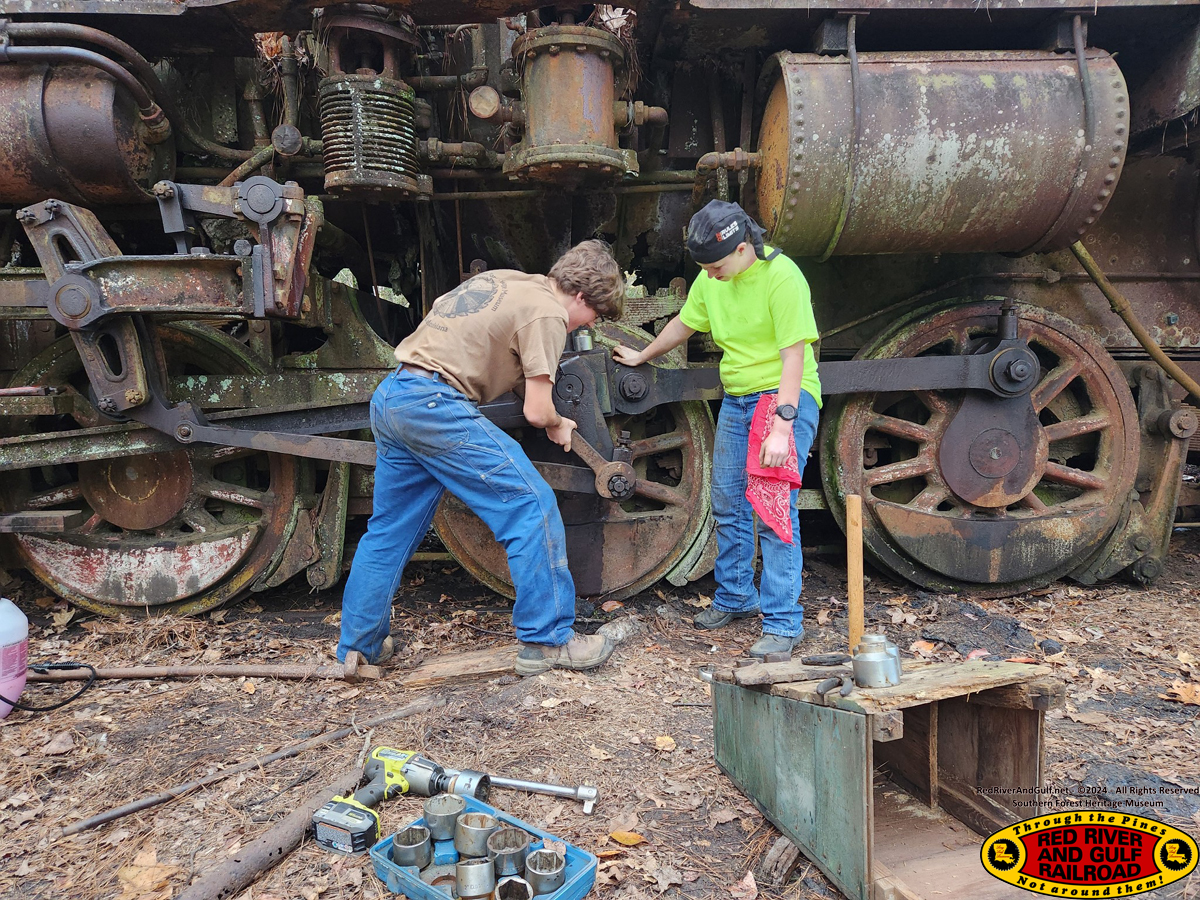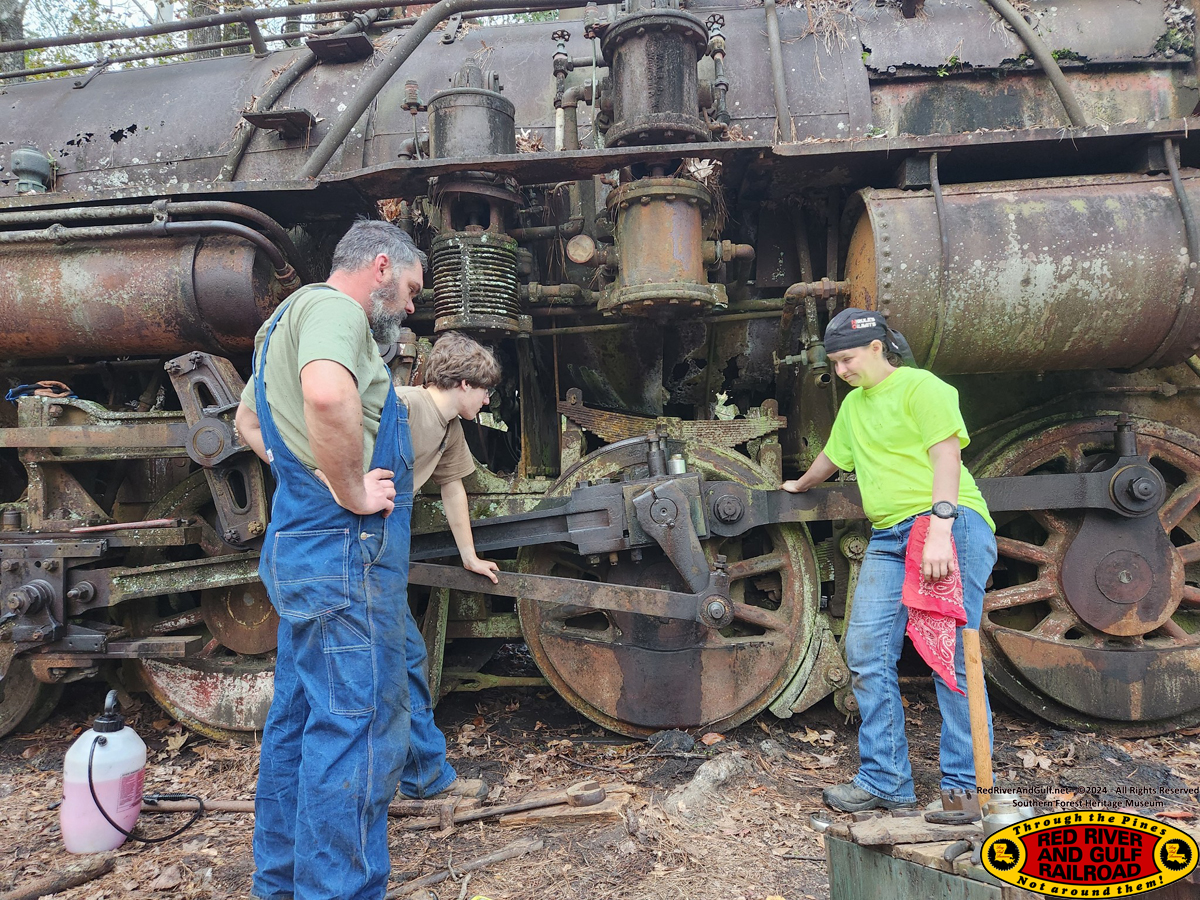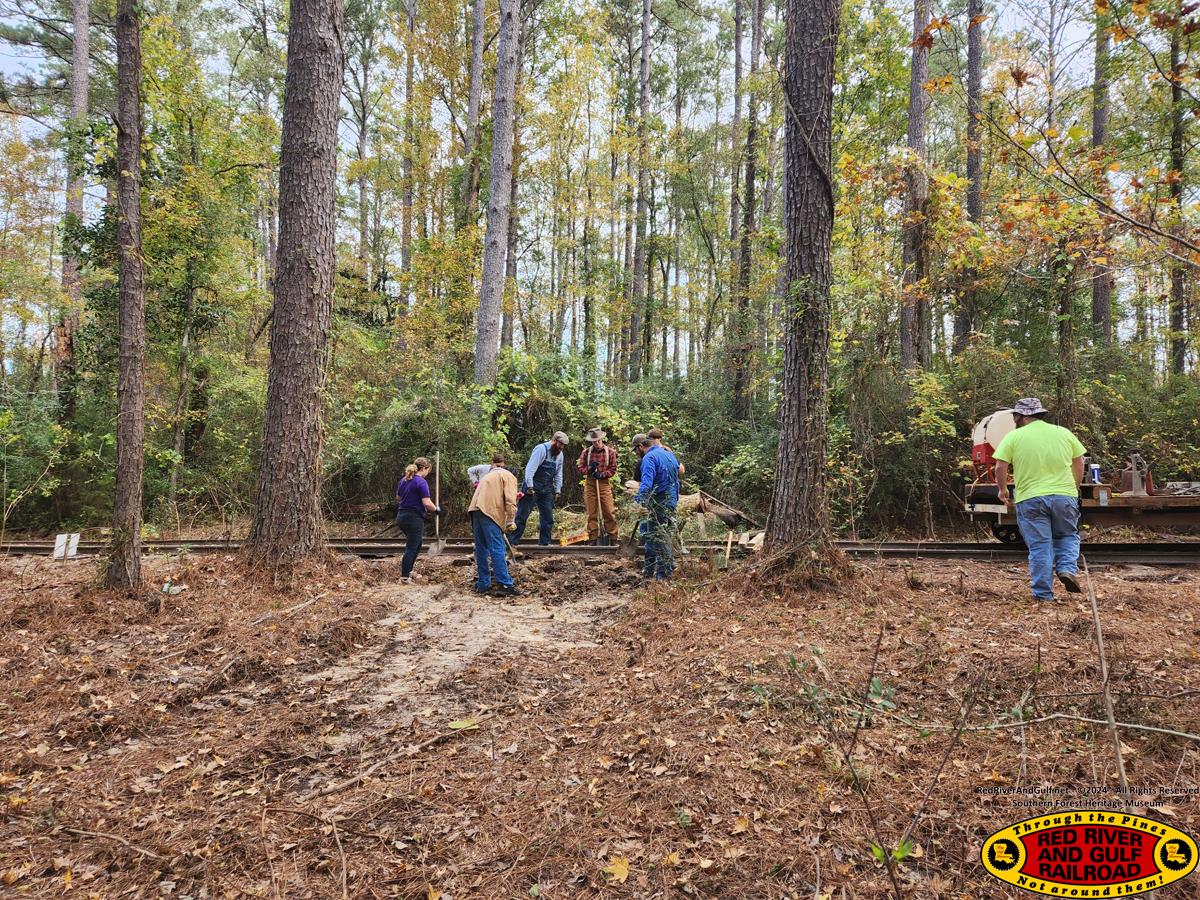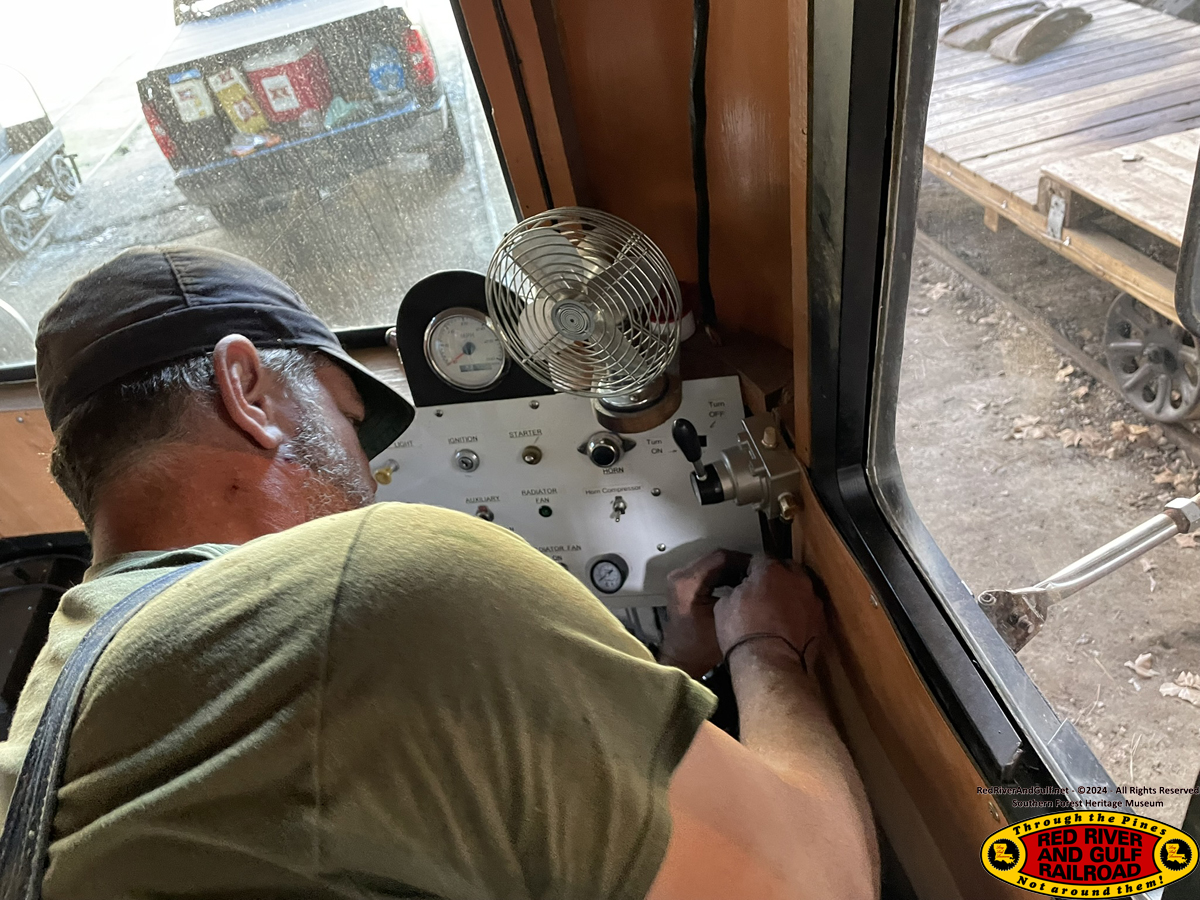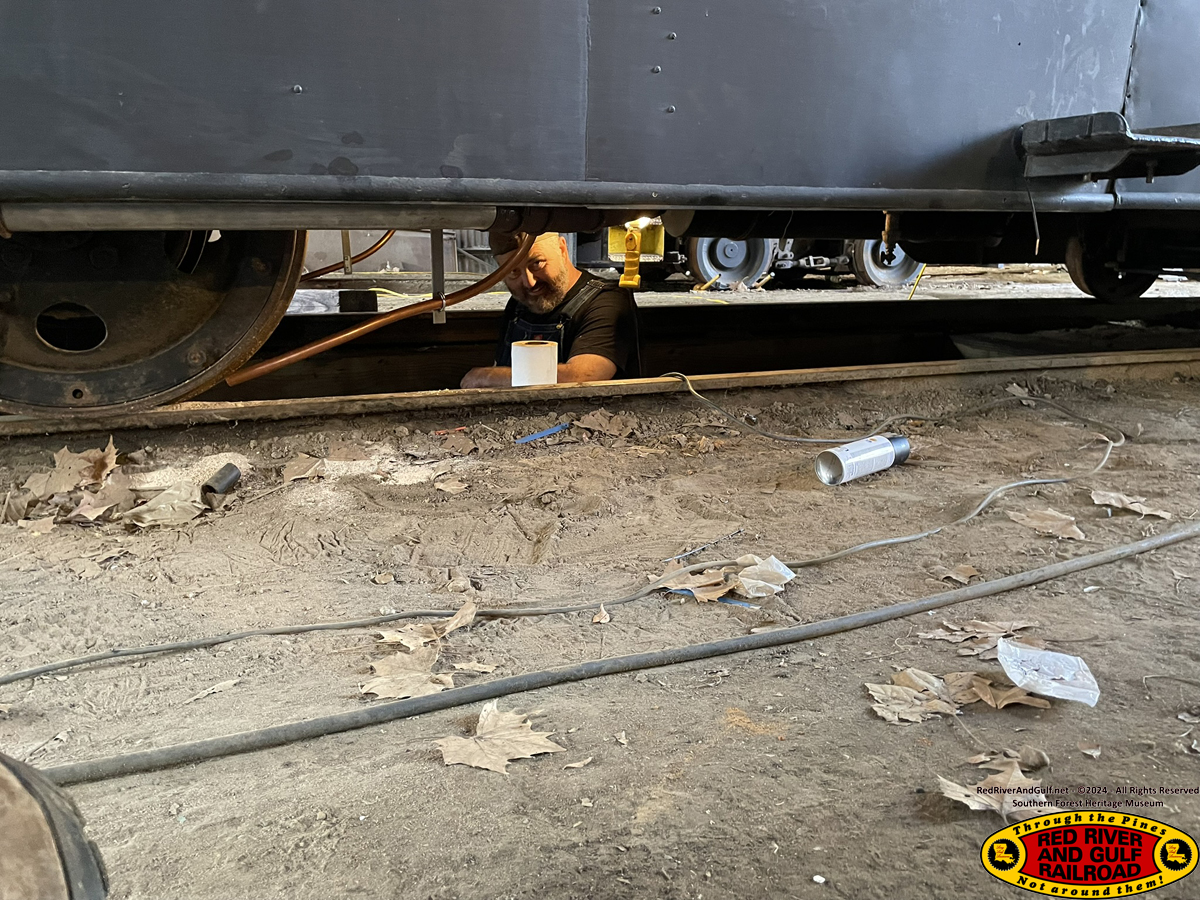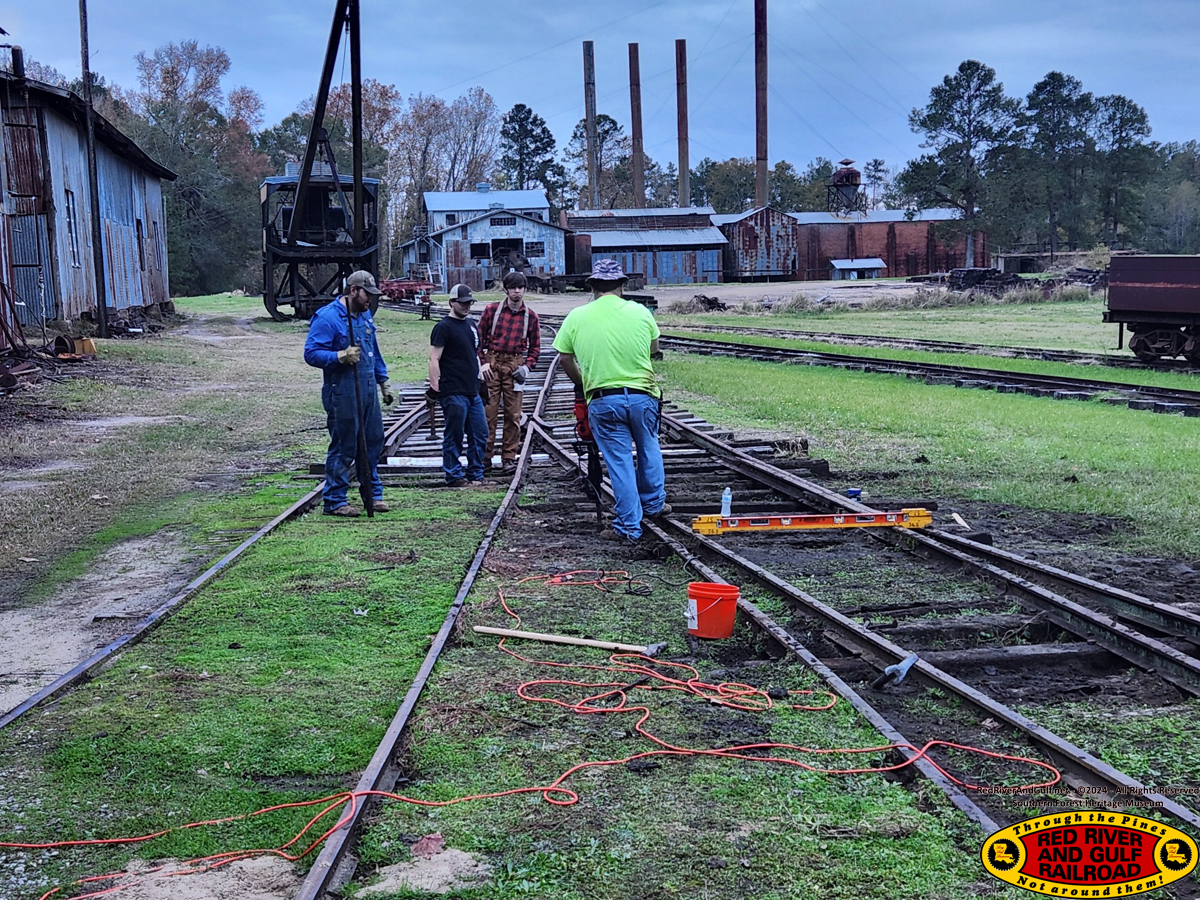|
Volunteers
1. Cody A.
2. Casey A.
3. Nick P.
4. Clint L. Jr
5. Everett L.
6. Mike M.
7. Glen A.
8. Joseph S.
9. Wimbley V.
10. Michael P.
11. Ayden S.
12. Kira S.
13. Tabitha D.
14. Abby D.
15. Tucker B.
16. Angela A.
17. Andrew A.
Accomplishments
1. Machine shop west wall beams replaced and wall secured
2. Forward-direction sanders installed on M4
3. Track cross level on main loop hill fixed
4. Additional guard rail installed at main line junction switch
5. Continued progress freeing up and lubricating locomotive 400
6. 5 ties installed on track leading to locomotive 400
7. Continued clean up and organization in the finished lumber shed
Thank you to all the volunteers that came and closed out 2024 with
continued progress at the museum this weekend. Your time and talent is
greatly appreciated. A big thank you for the Akins for their fabrication
and installation of forward sanders on M4!
May all the volunteers enjoy a merry Christmas and we’ll all join
together again in the upcoming new year.
Before the Weekend
For many weeks before December 14, the Akin brothers had fabricated two
new sanding boxes at their home shop based on a sanding box from M4.
They did the whole nine yards, fabrication, painting, testing, and
ultimately, successful installation on M4. This session was the
long-anticipated installation of sanders on M4.
Friday
Friday morning, Glen came and worked with John (staff) installing a new
door at the Long Leaf Post Office. He then went up to the engine house
to take photos of M8’s engine. After a compression test in mid-December
by Glen and Mike M., it was determined that the rings and likely several
valves needed replacement. Glen found a source for the Waukesha Engine
parts for a rebuild. In the afternoon, Glen helped Mike B on one of the
Heisler trucks.
After the executive committee meeting, Tucker and Doug reviewed the
upcoming projects as part of the greater sawmill restoration,
maintenance, and improvement push. There’s several smaller “projects
within projects” at the sawmill and several of these we’ll tackle in
2025.
Friday afternoon, Wimbley, Michael, and Tucker used picks and shovels to
clear the flangeways and switch frog on the track behind locomotive 400.
This allowed for inspection of the ties (if any remain) on this track.
As expected, ties will need to be inserted to facilitate 400’s move.
Friday evening Wimbley, Michael, and Tucker continued clean up and
organization of the finished lumber shed, focusing on the tractor and
lawn mower shed area. Several bucket-loads of garbage were taken to the
dumpster, good lumber was organized for use the next day leveling track,
scrap metal was collected and placed behind the sawmill green chain, and
the area was given a good organizing. This is an effort that will
continue as time allows.
Saturday
The volunteers met for the briefing at the lodge kitchen and then split
into groups to work on a beautiful Louisiana Saturday morning.
Joseph inspected the all-terrain forklift after its fits at the last
session. After clearing some debris in the fuel line, the forklift ran
normally. The debris was after the fuel filter, so it may be the fuel
line degrading. Joseph connected a battery charger to the forklift and
then on Sunday, he successfully started and ran the forklift a few times
to ensure everything was in working order.
After the forklift, Joseph led the effort on locomotive 400 for the day.
He brought used motor oil, diesel, acetone, and automatic transmission
fluid for the job. The ATF and acetone was used as a rust-penetrant to
free up several joints and connections. The oil was used for lubrication
in various spots. Assisting throughout the day on 400 was Angela, Nick,
Michael, Everett, and others. Joseph brought an air line, Mike M lent an
airline, and the shop air line was all connected together to run an
airline out to 400 to clean out ports, holes, threads, etc.
Up at the engine house, Cody and Casey worked from “can til can’t”
installing the forward-direction sanders on M4. Two seats were
temporarily removed from M4 so the holes for the sandbox filler necks
and carriage bolts could be cut in the floor. Everett and Joseph
assisted in procurement of bi-directional air sanding valve and pressure
regulators for the airline. Cody and Casey completed the installation,
including sand line down to the wheels/rail, connection to the sanding
valve, and installation of air line and regulators.
Next door at the machine shop, a third crew of Glen and Mike M worked on
the machine shop west wall. Several lateral beams had been replaced in
the wall several years ago, however, they were replaced with smaller
beams, resulting in several unfavorable multi-joint beam meets.
Throughout the rest of the machine shop walls, you could see the
original, proper beam lengths and how they maintained a very strong wall
structure. This situation on the west wall partially led to the wall
bend during a major high wind event in the area earlier in May. Mike
measured and then ordered two quality 20-foot beams in advance and had
them on hand for the session. Mike even positioned some beam supports
and braces with additional lumber until the repair could be completed.
Mike and Glen completed the lower section of the west wall, replacing
the damaged sections of 2x8s with the new beam. The upper beam will
require temporary scaffolding to reach, to be completed at a future
date. Raising the beam to the top side of the window will be
challenging! The goal is to change the framework of that window so that
it can be opened as intended and strengthen the wall. With the wall
secured in place, another upcoming project will be installing landscape
timbers/ties to function as an erosion control wall / dirt retaining
wall on this side of the machine shop.
A fourth crew of Wimbley, Michael, Tabitha, Ayden, Abby, Andrew, Tucker,
Everett, Clint, and Kira went out on the main loop with M2 and the
herbicide car loaded with old lumber pieces to level the hill track in a
few spots. Much material is recycled at Long Leaf, and lumber found and
/or leftover from other projects is reused. A piece of lumber rotten on
one end or one spot is still good - cut out the bad and put it to use
leveling track. Using track jacks to raise the track, blocks were cut
from lumber, knocked under ties, and the ties tamped to hold level. The
next good rain will then fill in dirt ballast completely under the ties.
The crew raised and fixed about 5 areas on the hill track, making a good
improvement for the morning.
After lunch, Everett, Joseph, and Tucker inspected the spot where Joseph
derailed on M2 a few weeks prior. After checking cross level and gauge,
it was decided to install another rail to function as a longer guard
rail on the uphill side (machine shop side). As Cody, Casey, and Everett
made a hardware supply run into Alexandria, Tucker, Andrew, Clint,
Michael, Wimbley, Tabitha, Ayden, and Abby tackled the guard rail
installation. Tucker and Andrew used the tractor to bring over a bent 60
pound rail from the pad, one that would work as a guard rail but would
not do for standard track rail. Running electrical cords from the
machine shop, holes were drilled, the rail held in place with lining
bars, and spikes driven in to hold the newest guard rail in place. M2
tested operation over the guard rail and all was found to be in good
order.
After the hardware run, Cody and Casey continued their work on the M4
sand boxes. Nick, Everett, Angela, and others continued to work in and
around locomotive 400. With the tractor and the track tools on hand,
Michael, Tabitha, Wimbley, Abby, Ayden, Clint, Tucker, and Andrew
installed 5 ties on the track leading to 400 at Switch #5, lower Clyde
siding. This involved digging out slots for the ties, removal of old tie
debris, sliding in ties, gauging the track, drilling holes, and using
the electric hammer to drive in the spikes. Being right next to the
engine house, extension cords were run to power the electric tools.
In the evening, as Cody and Casey continued working on the M4, Joseph
and Tucker worked on installing hinges for the two M4 seats that would
sit above the sand box filler necks. Leftover spare lumber was measured
and cut by Joseph, and after sorting through a screw bucket to find a
matching set, the first hinged seat was put together.
Everett, Angela, and Andrew, noticing some lights bulbs out in the
engine house, grabbed a ladder and the light bulb extension pole to
install new light bulbs. The spring holding the light bulb grabbing end
on the pole broke on the 2nd bulb change, so Everett planned on getting
a new one and a few more light bulbs that evening.
Sunday
On Sunday, the volunteers finished up some efforts and continued others.
Everett and Angela changed out the burnt-out light bulbs in the engine
house with the new light bulb extension pole Everett got the night
before.
Joseph continued lubricating 400 and working toward dropping the
eccentric crank connections.
Andrew and Tucker completed the hinges on the second M4 seat. Once Cody
and Casey were done with the sanders, the two seats were reinstalled in
the M4. The hinge action was found to be satisfactory to access the
sanders for refilling in the future.
Once the sanders were complete, Cody, Casey, Joseph, and Tucker went to
fire up M4 and to take it for a test spin. After initially starting up
fine, the engine puttered out. Fuel level was checked, and more fuel was
put in. Still the issue of starting and struggling then dying out
persisted. After troubleshooting the engine, the issue was found to be
with the carburetor. After testing with the idle screws, pinching the
fuel line, and other tests, the float was not working properly, allowing
in fuel inadvertently. The matter would be followed up on with the staff
and potentially more troubleshooting at the next session.
Wrapping up the session was the lodge clean up. Everett went through
upstairs making sure all was in order. Joseph and Tucker emptied garbage
cans, swept the kitchen, and mopped the bathrooms, kitchen, and even the
front porch. That way the lodge starts clean for the new year in 2025.
After the Weekend
Gerald (staff) checked the M4 carburetor, and sure enough, there was an
issue with the float. Debris had gotten in, causing the float to not
work. He cleared it and reinstalled the now-working-again carburetor.
Mike M has already plumbed a metal fuel line with a new fuel pump, but
hasn’t switched over the line yet. He’ll do so soon to replace the
rubber fuel line, which is potentially degrading and causing its debris
to get into the carburetor.
Glen moved the M-8 to his shop on December 23rd. The engine is scheduled
to be disassembled, and the cylinders will be measured for rings and
valves before ordering any parts. Glen hope’s to perform this without
removing the engine block from the car for the rebuild. Removing the
front wheels and axle should provide ample clearance to remove the oil
pan to access the connecting rods. A speedometer will also be installed
before its return. He’s unsure of the rebuild time, but I hope to have
it back as soon as possible. After researching the M-8 engine, Glen
reports he found it to be a FC(Parson) engine. The serial # FC86K was
built between 1937-1946. The 3-1/4" bore is rated at 35HP@ 2400 RPM;
Most were produced for the Fairmont A-5 railcar.
Trivia- The F= Full compression lubrication
The C= Comet Conversion, Military High Output
The K= Larger Bore, Kerosene fueled engine after WWII
-Tucker "Who Dat" Baker
RR&G
Chief Engineer
|
